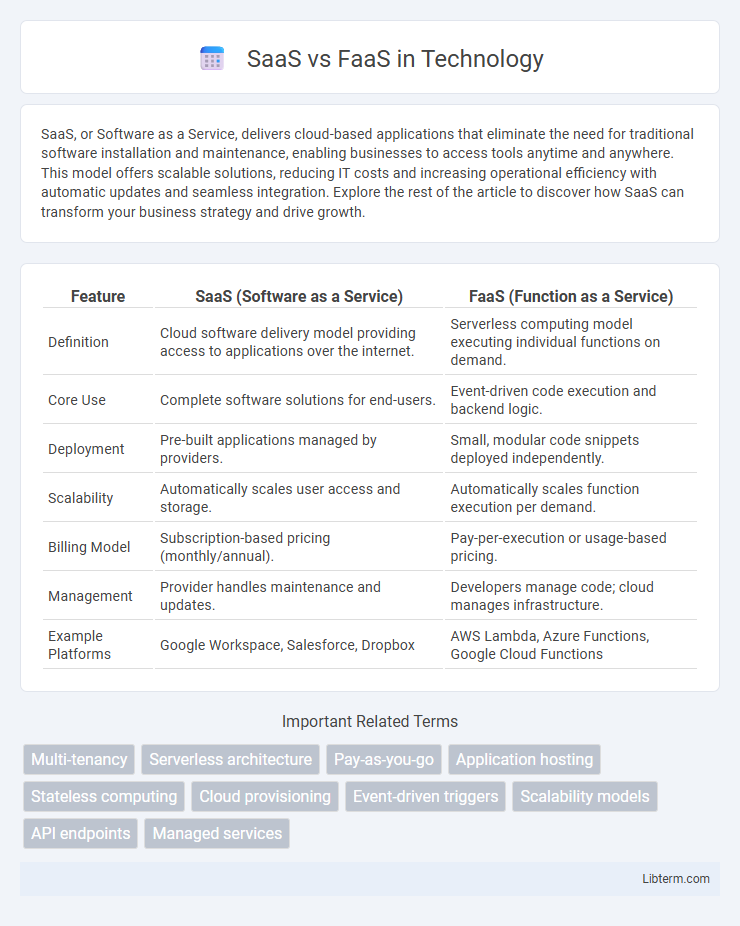SaaS, or Software as a Service, delivers cloud-based applications that eliminate the need for traditional software installation and maintenance, enabling businesses to access tools anytime and anywhere. This model offers scalable solutions, reducing IT costs and increasing operational efficiency with automatic updates and seamless integration. Explore the rest of the article to discover how SaaS can transform your business strategy and drive growth.
Table of Comparison
| Feature | SaaS (Software as a Service) | FaaS (Function as a Service) |
|---|---|---|
| Definition | Cloud software delivery model providing access to applications over the internet. | Serverless computing model executing individual functions on demand. |
| Core Use | Complete software solutions for end-users. | Event-driven code execution and backend logic. |
| Deployment | Pre-built applications managed by providers. | Small, modular code snippets deployed independently. |
| Scalability | Automatically scales user access and storage. | Automatically scales function execution per demand. |
| Billing Model | Subscription-based pricing (monthly/annual). | Pay-per-execution or usage-based pricing. |
| Management | Provider handles maintenance and updates. | Developers manage code; cloud manages infrastructure. |
| Example Platforms | Google Workspace, Salesforce, Dropbox | AWS Lambda, Azure Functions, Google Cloud Functions |
Introduction to SaaS and FaaS
Software as a Service (SaaS) delivers cloud-based applications accessible via the internet, enabling users to utilize software without local installation or management. Function as a Service (FaaS) provides a serverless computing model where developers deploy individual functions that execute in response to events, optimizing scalability and resource usage. Both SaaS and FaaS eliminate traditional infrastructure concerns but cater to different cloud service needs--SaaS emphasizes application delivery, while FaaS focuses on event-driven code execution.
What is SaaS?
SaaS (Software as a Service) delivers software applications over the internet on a subscription basis, eliminating the need for local installation and maintenance. It enables users to access fully managed software solutions, such as CRM, ERP, and collaboration tools, through web browsers from any device. SaaS providers handle infrastructure, security, and updates, allowing businesses to scale efficiently and reduce IT overhead.
What is FaaS?
Function as a Service (FaaS) is a cloud computing model that allows developers to deploy individual functions or pieces of code without managing servers, enabling event-driven execution and automatic scaling. Unlike Software as a Service (SaaS), which delivers complete software applications over the internet, FaaS provides granular control over backend logic with flexible pay-per-use pricing models. Key providers such as AWS Lambda, Google Cloud Functions, and Azure Functions dominate the FaaS market, offering rapid deployment and cost efficiency for microservices and serverless architectures.
Key Differences Between SaaS and FaaS
SaaS (Software as a Service) delivers fully managed software applications accessible via the internet, ideal for end-users seeking ready-to-use solutions. FaaS (Function as a Service) provides serverless computing where developers deploy individual functions triggered by events, optimizing scalability and cost-efficiency. Key differences include SaaS focusing on complete applications with subscription models, whereas FaaS emphasizes modular function execution with pay-per-use billing.
Use Cases for SaaS
SaaS (Software as a Service) is widely used for delivering cloud-based applications such as CRM, collaboration tools, and email platforms, enabling businesses to access software over the internet without local installation. Use cases include project management with tools like Asana, customer relationship management via Salesforce, and content management through platforms like WordPress. SaaS solutions offer scalability, automatic updates, and multi-device accessibility, making them ideal for organizations seeking flexible, subscription-based software models.
Use Cases for FaaS
FaaS (Function as a Service) excels in event-driven architectures, enabling automatic scaling and cost-efficiency for applications with unpredictable workloads such as real-time data processing, IoT device management, and serverless web application backends. Use cases include executing backend logic triggered by HTTP requests, processing streaming data from platforms like AWS Kinesis or Azure Event Hubs, and running asynchronous tasks such as image or video processing. This granular, function-level execution model reduces infrastructure management compared to traditional SaaS platforms, making FaaS ideal for microservices and APIs requiring rapid, isolated responses.
Advantages of SaaS
SaaS (Software as a Service) offers significant advantages including easy accessibility through web browsers, eliminating the need for local installations and reducing IT maintenance costs. It provides automatic updates and scalability, allowing businesses to quickly adapt to changing demands without infrastructure changes. SaaS platforms often deliver robust security measures and seamless integration with other software, enhancing overall operational efficiency.
Advantages of FaaS
FaaS (Function as a Service) offers exceptional scalability by automatically handling infrastructure management and resource allocation based on demand, reducing operational overhead. It enables rapid development and deployment through event-driven architecture, allowing precise execution of discrete functions without maintaining entire applications. Cost efficiency is enhanced since charges are incurred only for actual function execution time, eliminating costs related to idle server capacity common in traditional SaaS models.
Choosing Between SaaS and FaaS
Choosing between SaaS and FaaS depends on your project's specific needs for scalability and customization. SaaS offers fully managed software solutions with minimal maintenance, ideal for businesses seeking quick deployment and standard features. FaaS provides granular control and event-driven functions, making it suitable for applications requiring flexible, on-demand compute resources and cost efficiency.
Future Trends in SaaS and FaaS
Future trends in SaaS emphasize enhanced AI integration, enabling predictive analytics and personalized user experiences to streamline business operations. FaaS, or Function as a Service, is projected to grow rapidly with serverless architectures optimizing real-time processing and reducing infrastructure costs for cloud-native applications. Both SaaS and FaaS will increasingly leverage edge computing and automation to improve scalability, agility, and developer productivity in cloud ecosystems.
SaaS Infographic

 libterm.com
libterm.com